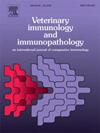猪免疫试剂的研究进展与挑战
IF 1.4
3区 农林科学
Q4 IMMUNOLOGY
引用次数: 0
摘要
科学家需要猪免疫试剂来揭示对传染病和疫苗的潜在反应机制。这篇综述强调了用于评估复杂细胞和组织相互作用的抗体和免疫蛋白的可用性,以及确保研究界继续使用最佳试剂所涉及的问题。本文还讨论了猪免疫蛋白和单克隆抗体(mab)的生产、表征和可用性,这些单克隆抗体与这些蛋白和免疫细胞亚群CD(分化簇)标记物反应。最后,对兽医免疫工具包工作的未来投资提出了建议。本文章由计算机程序翻译,如有差异,请以英文原文为准。
Progress and challenges in developing swine immune reagents
Swine immune reagents are required for scientists to reveal the mechanisms underlying responses to infectious disease and vaccines. This review highlights availability of antibodies and immune proteins to assess complex cellular and tissue interactions and the issues involved in assuring the best panel of reagents continue to be available for the research community. Continuing issues are discussed for the production, characterization and availability of expressed swine immune proteins and monoclonal antibodies (mAbs) reactive with those proteins and immune cell subset CD (cluster of differentiation) markers. Finally, suggestions are presented for future investments in veterinary immune toolkit efforts.
求助全文
通过发布文献求助,成功后即可免费获取论文全文。
去求助
来源期刊
CiteScore
3.40
自引率
5.60%
发文量
79
审稿时长
70 days
期刊介绍:
The journal reports basic, comparative and clinical immunology as they pertain to the animal species designated here: livestock, poultry, and fish species that are major food animals and companion animals such as cats, dogs, horses and camels, and wildlife species that act as reservoirs for food, companion or human infectious diseases, or as models for human disease.
Rodent models of infectious diseases that are of importance in the animal species indicated above,when the disease requires a level of containment that is not readily available for larger animal experimentation (ABSL3), will be considered. Papers on rabbits, lizards, guinea pigs, badgers, armadillos, elephants, antelope, and buffalo will be reviewed if the research advances our fundamental understanding of immunology, or if they act as a reservoir of infectious disease for the primary animal species designated above, or for humans. Manuscripts employing other species will be reviewed if justified as fitting into the categories above.
The following topics are appropriate: biology of cells and mechanisms of the immune system, immunochemistry, immunodeficiencies, immunodiagnosis, immunogenetics, immunopathology, immunology of infectious disease and tumors, immunoprophylaxis including vaccine development and delivery, immunological aspects of pregnancy including passive immunity, autoimmuity, neuroimmunology, and transplanatation immunology. Manuscripts that describe new genes and development of tools such as monoclonal antibodies are also of interest when part of a larger biological study. Studies employing extracts or constituents (plant extracts, feed additives or microbiome) must be sufficiently defined to be reproduced in other laboratories and also provide evidence for possible mechanisms and not simply show an effect on the immune system.

 求助内容:
求助内容: 应助结果提醒方式:
应助结果提醒方式:


